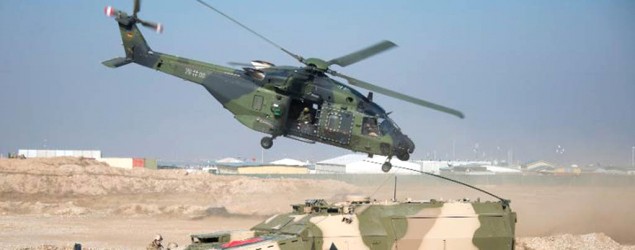Pentagon moving ahead with new vertical lift aircraft
BY ANDREA SHALAL
HUNTSVILLE, Alabama Fri Feb 21, 2014 11:47pm EST

A U.S. military AH-64 Apache assault helicopter flies past a bunker of U.S. soldiers from Task Force ''No Fear'' 3rd Platoon, 2-27 Infantry ''The Wolfhounds'', after engaging in firefights with the Taliban, in Ghaziabad district in Kunar, Afghanistan September 15, 2011.
CREDIT: REUTERS/ERIK DE CASTRO
(Reuters) - The Pentagon is committed to early design work on a new aircraft that will replace thousands of helicopters now used by the U.S. military, its first "clean sheet design" program in years, the Army official heading the effort said on Friday.
Dan Bailey, a former Apache helicopter pilot who heads the "future vertical lift" program and the research effort under way to explore possible approaches, said there was no push to reduce funding for the program, despite pressure on nearly every other arms program in the Pentagon's portfolio.
"The science and technology effort is supported 100 percent," Bailey told reporters at a conference hosted by the Association of the U.S. Army, an Army booster group. "That's significant on its own. There is no other portfolio that is not feeling a significant cut."
U.S. weapons makers have expressed concern that big cuts in military spending could undermine the program, one of very few new research and development efforts seen in decades, but Army officials last week said the effort was a key priority.
Army acquisition chief Heidi Shyu and General Dennis Via, who heads Army Materiel Command, both underscored their support for the program in speeches at the conference.
Bailey said Pentagon budget officials left funding intact for the "joint multirole" technology demonstration project, the precursor to the future vertical lift aircraft, a program that analysts say could be worth upwards of $100 billion.
He said the Pentagon expected to spend $354 million between 2011 and 2019 on the science and technology phase, but declined to estimate what the later development program would be worth.
Current plans call for an analysis of possible approaches for the new rotorcraft in 2016 or 2017, followed by a decision to move forward around 2018 and a contract award around 2020.
Ultimately, the program will replace between 2,000-4,000 medium class UH-60 Black Hawk utility helicopters built by Sikorsky Aircraft, a unit of United Technologies Corp and Boeing Co AH-64 attack helicopters after 2030.
He said details were still being worked out for funding the subsequent production program, but it would not require major funding until it enters production around 2029 or 2030.
LEARNING FROM MISTAKES
The Army last year chose four industry teams to do early work on concepts for a new vertical lift aircraft, and will winnow the field later this year, although it insists that the actual production program will involve another competition.
The four are Textron Inc's Bell Helicopter unit, which is teamed with Lockheed Martin Corp; Sikorsky, teamed with Boeing; AVX Aircraft and Karem Aircraft.
Bailey told Reuters in an interview later that his office was trying to learn from mistakes made on earlier complex arms programs, including Lockheed's F-35 fighter program, which is also being developed for use by a number of military services.
He said the key to success was starting early and working closely with industry to understand what technology solutions were possible, rather than pre-determining the outcome.
The Army is focused heavily on getting affordable aircraft that will be cheaper and easier to maintain than current helicopters, he said.
The program also works closely with the "Vertical Lift Consortium," an industry group that includes a broad array of suppliers involved in the sector. Bailey said members of the group's executive board participate in high-level meetings on the program at the Pentagon, along with senior officers.
"We want to make sure that we're a team; that we're all aligned and that we're moving in the same direction," he said. "We understand that if we don't have that industrial partner base, then the next-generation vertical lift will not be available to us 60 years from now."
He said work on the technology concepts was already re-energizing industry, prompting companies to hire new engineers, and revamp and update their computer-based design tools.
"This is the next big thing," said Sam Mehta, president of Sikorsky's Defense Systems and Services division.
He said Sikorsky's collaboration with Boeing on the program was going well. "We are developing things with Boeing that neither of us could have developed on our own or in the same period of time."
(Editing by Robert Birsel)





 本城市首頁
本城市首頁









































